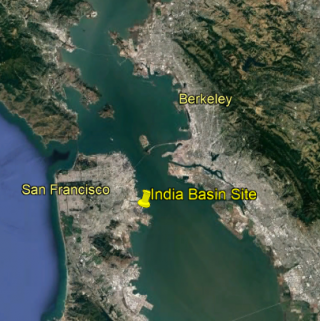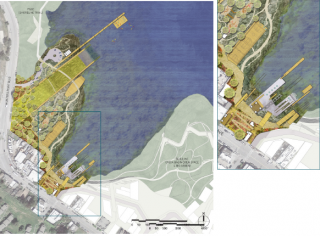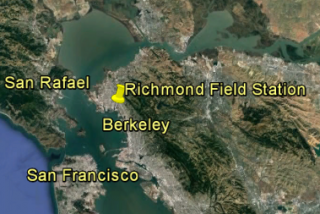Pacific Southwest PCB Success Stories: Preventing PCB Migration into Coastal Waters
Related Content: PCB Success Stories | Pacific Southwest PCBs Program
- Southern
California - Northern
California - Utility
Cleanups - Renovation/
Reuse Projects - Preventing
PCB Migration
- India Basin Site: PCB Cleanup Readies San Francisco Shoreline Site for Waterfront Park
- UC Berkeley Richmond Field Station: Cleanup of PCB-Impacted Marsh Near San Francisco Bay
India Basin Site
PCB Cleanup of Former Ship Building & Repair Site in San Francisco’s Bayview Neighborhood
PCB cleanup readies San Francisco shoreline site for waterfront park.
The San Francisco Recreation and Parks Department (SFRPD) plans to redevelop a 2.4-acre site, a quarter of which is off-shore, to create a connected network of improved parkland and open space along the City’s southern shoreline. The site served as a boat building and/or repair facility for over 120 years, originally to build scow schooners to transport goods around the Bay. The “Alma”, a National Historic Landmark, was built there in 1891. The final boat repair operation at the site closed in the 1990s.
All structures on site were demolished due to poor condition except for one building of historical significance, Shipwright’s Cottage, built in 1875. The City received several EPA Brownfields grants to support assessment and cleanup of contaminants on the property. Studies conducted over the past seven years identified elevated levels of polychlorinated biphenyls (PCBs) in soils and sediment.
Starting in the 1940s PCBs were added to marine paint to improve adhesiveness and anti-corrosion properties until the manufacture of PCBs was banned in 1977. Other contaminants found in site soils include lead, nickel, and polycylic aromatic hydrocarbons (PAHs).
EPA Action
EPA has oversight for cleanup of PCB-contaminated soil and other materials under the Toxic Substances Control Act (TSCA). The highest concentrations of PCBs were found in the vicinity of the historical boat launch area and west central portion of the site and in localized near-shore sediments.
In June 2021 EPA approved a TSCA application submitted by the SFRPD to clean up PCBs at the site through a combination of soil excavation, sediment dredging, and localized offshore sand cover. Over 18,800 cubic yards of soil and sediment were removed for off-site disposal. A relatively small area of the site was found to contain PCBs over 50 milligrams per kilogram that required disposal at a hazardous waste facility per EPA’s approval.

Two discrete offshore PCB-impacted areas were covered with 6 to 12 inch sand caps to protect fish and other aquatic life from exposure to PCB concentrations that exceeded sediment cleanup levels. These include a not-to-exceed level of 1,240 micrograms per kilogram (µg/kg) and an area-weighted average level of 148 µg/kg that is also being applied at nearby cleanup sites such as Yosemite Slough and Hunters Point Naval Shipyard Parcel F. EPA worked in coordination with the San Francisco Regional Water Quality Control Board which is overseeing cleanup of metals and PAHs. The remediation portion of the project is complete.
UC Berkeley Richmond Field Station
Cleanup of PCB-Impacted Marsh Near San Francisco Bay
Marsh cleanup helps protect endangered California bird.
The 170-acre Richmond Field Station (RFS) owned by the University of California at Berkeley is used for academic research and teaching. The site encompasses 60 acres of offshore marsh and native coastal grasslands that serve as habitat for monarch butterflies and nesting birds, including the endangered California Ridgway’s Rail.
Between 1877 and 1950, the California Cap Company manufactured dynamite caps for high explosives on a 30-acre portion of the site later purchased by UC Berkeley. The Cap Company plant consisted of approximately 150 buildings. On a neighboring property to the east, a former chemical manufacturing company (later Zeneca, Inc.) manufactured sulfuric acid and other chemicals between 1897 and 1960 that created pyrite cinder waste.
Testing for environmental contaminants in soil, groundwater, and sediment began at the site in 1999. The investigation revealed areas contaminated with mercury from the former dynamite cap production, as well as heavy metals associated with pyrite cinder waste. Mercury and polychlorinated biphenyls (PCBs) of unknown origin were found in Western Stege Marsh, north of a public walking trail. The highest concentration of PCBs (61,000 parts per million, or ppm) was found in a storm drain outfall to the marsh, potentially attributable to former activities of an off-site source. From 2002-2004, under the direction of the San Francisco Bay Regional Water Quality Control Board (RWQCB), 62,300 cubic yards of soil, sediment, and other material from a large portion of Western Stege Marsh was excavated and removed.
EPA Action

In August 2017, UC Berkeley submitted a PCB Remedial Action Plan to EPA for cleanup of soils in locations impacted by a former small electrical transformer and maintenance facility at the site. EPA has oversight for cleanup of PCB-contaminated soil, concrete, and other materials under the Toxic Substances Control Act (TSCA). EPA expeditiously approved the plan in September 2017, providing for cleanup to 1 ppm on the condition that UC Berkeley would adopt a deed restriction prohibiting residential use. Most soils in the former transformer site and maintenance yard have been excavated for appropriate disposal.
Elsewhere on the RFS, UC Berkeley remediated two PCB-impacted soil piles from a meadow. Soil from a PCB-impacted storm drain was placed on the meadow in the early 1990s. EPA determined that cleanup of PCBs in soil to 1 ppm would be protective of marsh wildlife exposed to stormwater runoff from the meadow. In September 2018, EPA approved UC Berkeley’s plan to remove for off-site disposal approximately 1,000 cubic yards of PCB-impacted soil from the meadow. In addition, EPA required removal of any sediment within existing storm drains affected by the site, along with storm drain flushing and placement of straw sediment filters at the inlets to prevent further impacts to the marsh. This remediation project is now complete.

UC Berkeley’s monitoring of the remediated portion of Western Stege Marsh following the 2004 cleanup shows that it is progressing towards functioning as a typical San Francisco Bay tidal salt marsh. In 2018, EPA requested UC Berkeley to conduct an initial survey of Ridgway Rails in the marsh. The survey identified multiple nests.
UC Berkeley tested soils for PCB content in the remaining portion of Western Stege Marsh in 2018, indicating elevated concentrations up to 41 ppm. EPA is coordinating with the U.S. Fish and Wildlife Service, San Francisco Bay RWQCB, California Department of Toxic Substances Control, California Department of Fish and Wildlife, and San Francisco Bay Conservation Development Commission to evaluate cleanup alternatives. UC Berkeley plans to conduct additional surveys of Ridgway Rails in the marsh to inform cleanup decisions.





